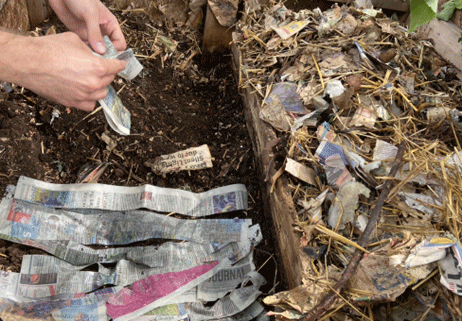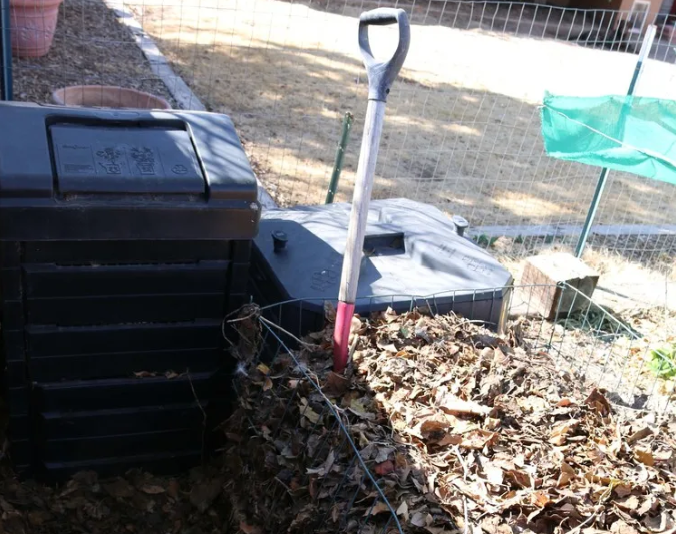Why is it important to compost? Between 30 and 50 percent of residential waste could be composted instead of put in a landfill, which would reduce the volume of trash and the production of greenhouse gas. Compost is nature’s way of recycling nutrients by using microbes to help break down organic material. The end result is a nutrient-rich soil amendment with an earthy aroma that improves soil and plant health and can eliminate the need for fertilizers.

Two of the Easiest Methods for Composting
- Bin composting
- Vermicomposting (worm composting).
If you have limited outdoor space for composting, consider the Bokashi bucket method or explore other options. There are also community-based composting programs in Albuquerque. To find a composting option in your area, simply enter “composting near me” into your Internet search engine.
The Four Required Elements for Backyard Bin Composting
- Moisture (water) to sustain the microbial life
- Nitrogen-rich materials, also referred to as “greens,” that heat up the compost pile to create ideal conditions for decomposition
- Carbon-rich materials, or “browns,” that provide food for the microorganisms and help balance the green materials
- Oxygen to maintain aerobic conditions necessary for the desired microbes
What Can be Composted?
| Greens (Nitrogen) | Browns (Carbon) |
| Food and vegetable scraps | Dry leaves |
| Grass clippings and yard trim | Shredded straw or hay |
| Coffee grounds and paper filters | Shredded paper (non-glossy, not colored) |
| Paper tea bags | Shredded cardboard (no wax coating, tape or glue) |
| Eggshells | Sawdust |
| Bread and grains | Wood chips |
| Fruit or fruit peels (limit citrus) | Paper towels and towel rolls |
Keep These Items Out of Your Compost
- Meat, fish and bones
- Dairy products
- Pet waste or cat litter
- Stickers left on produce
- Fats, oils and greases
- Aggressive weeds or weeds with seeds*
*Certain carefully-maintained compost techniques can kill seeds
How to Bin Compost
- Collect and store materials. An easy way to collect food scraps (greens) is to use a dedicated, washable container that can be stored under the sink or on the counter. When preparing meals, place scraps into this container. To avoid smells and pests, store the container in your fridge or freezer until you are ready to build or add to your pile. Browns, like leaves and wood chips, can be collected throughout the year and set aside until needed.
- Select a space and then build or buy a bin. Choose a space outside that is dry, shady, within reach of a watering hose and easily accessible. Next, build a compost bin system or purchase a three-bin system, barrel or tumbler.
- Prepare your browns and greens. Break large items into smaller pieces to speed up the process and create a more uniform product.
- Build your pile. Start your bin with a 4 to 6-inch layer of large-sized brown material like twigs and wood chips. Then, layer greens and browns like you’re making lasagna at a ratio of two parts brown to one part green. Finally, add water to dampen the compost pile so it is moist but not soaked. *Tip: Squeeze a handful of the compost. If a few drops fall, it is moist. If water streams out, it is too wet.
- Maintain the pile. As the material begins to decompose, the temperature will rise. Turn and mix your compost pile every few weeks so the decomposition process is sped up. Monitor the bin for moisture (damp, but not dripping) and odor (earthy, not stinky), and troubleshoot as needed.
| Compost Troubleshooting |
| Typical nitrogen to carbon ratio = 2:1 |
| Too much nitrogen = smelly compost |
| Too much carbon = won’t break down |
| Provide adequate air & moisture |
- Cure and use the finished compost. When there are no visible food scraps (except small pieces of eggshell), allow the compost pile to cure (sit unturned) for at least four weeks. If well-maintained, the whole process will take about three to five months.
Whether you decide to use a bin system, vermicompost or a different method, you will be turning waste into compost that builds healthy soils and sequesters carbon. To learn more about composting in New Mexico visit NM Master Composters and the NM Healthy Soil Working Group. Visit the City of Albuquerque for more information on the city’s sustainability efforts and tips for food waste prevention.
Learn more here:


